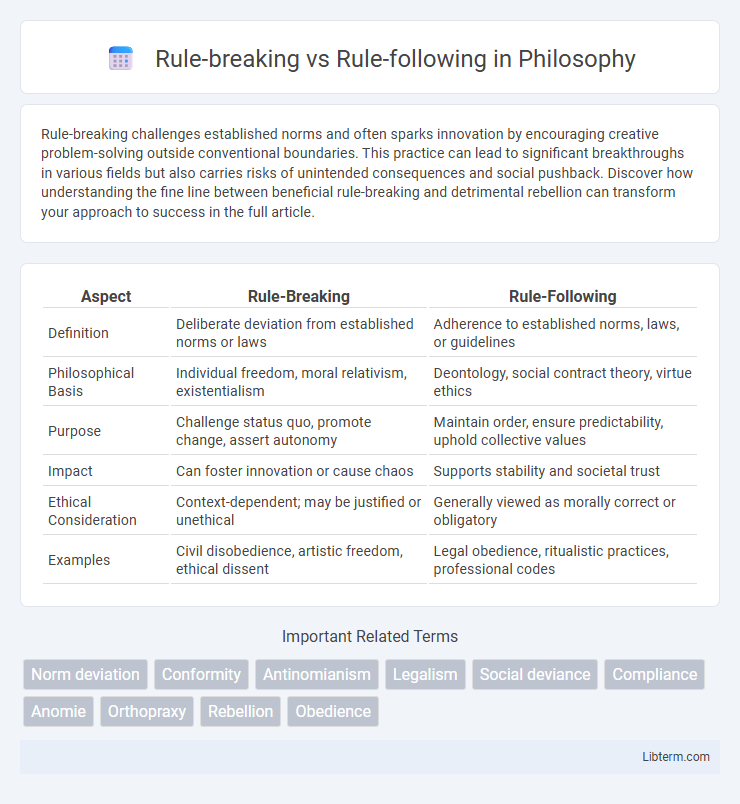Rule-breaking challenges established norms and often sparks innovation by encouraging creative problem-solving outside conventional boundaries. This practice can lead to significant breakthroughs in various fields but also carries risks of unintended consequences and social pushback. Discover how understanding the fine line between beneficial rule-breaking and detrimental rebellion can transform your approach to success in the full article.
Table of Comparison
| Aspect | Rule-Breaking | Rule-Following |
|---|---|---|
| Definition | Deliberate deviation from established norms or laws | Adherence to established norms, laws, or guidelines |
| Philosophical Basis | Individual freedom, moral relativism, existentialism | Deontology, social contract theory, virtue ethics |
| Purpose | Challenge status quo, promote change, assert autonomy | Maintain order, ensure predictability, uphold collective values |
| Impact | Can foster innovation or cause chaos | Supports stability and societal trust |
| Ethical Consideration | Context-dependent; may be justified or unethical | Generally viewed as morally correct or obligatory |
| Examples | Civil disobedience, artistic freedom, ethical dissent | Legal obedience, ritualistic practices, professional codes |
Defining Rule-Breaking and Rule-Following
Rule-breaking involves deviating from established norms, guidelines, or laws, often challenging conventional boundaries to foster innovation or address injustice. Rule-following entails adhering strictly to defined protocols and standards, ensuring consistency, order, and predictability within systems or societies. The balance between these behaviors shapes cultural evolution, governance effectiveness, and social dynamics.
Historical Perspectives on Rules
Historical perspectives on rule-breaking and rule-following reveal a complex interplay between societal order and innovation. Classical thinkers like Confucius emphasized rule-following to maintain harmony, while philosophers such as Socrates promoted questioning norms to advance morality and knowledge. Revolutionary movements across centuries demonstrate that strategic rule-breaking often catalyzes significant social and political transformations.
The Psychology Behind Rule Adherence
Rule adherence is driven by psychological factors such as the desire for social acceptance, fear of punishment, and internalized moral values. Cognitive processes, including conformity and obedience, reinforce compliance by aligning individual behavior with group norms. Neuroscientific studies highlight that the prefrontal cortex plays a crucial role in decision-making related to following or breaking rules based on risk assessment and reward anticipation.
Benefits of Rule-Following
Rule-following enhances organizational efficiency by ensuring consistent procedures and reducing errors, which leads to higher productivity. Adherence to established rules fosters trust and cooperation among team members, creating a stable and predictable work environment. Maintaining compliance with regulations also minimizes legal risks and supports long-term business sustainability.
Advantages of Rule-Breaking
Rule-breaking fosters innovation by challenging outdated conventions and encouraging creative problem-solving, which drives progress in industries and society. It empowers individuals to adapt swiftly to evolving circumstances, leading to unique solutions that rigid rule-following often stifles. Embracing rule-breaking can cultivate resilience and personal growth, promoting a culture of critical thinking and continuous improvement.
Rule-Breakers vs Rule-Followers in the Workplace
Rule-breakers in the workplace often challenge conventional processes, driving innovation and uncovering new opportunities for growth. Rule-followers maintain organizational stability by ensuring compliance, reducing risks, and upholding company policies. Balancing the strengths of both groups can enhance team performance and foster a dynamic yet disciplined work environment.
Social Implications and Perceptions
Rule-breaking challenges societal norms and can disrupt social order, often leading to stigmatization or marginalization of individuals who deviate from accepted behaviors. Rule-following reinforces social cohesion and trust, promoting stability and predictability within communities. Public perceptions of rule-breaking versus rule-following vary based on cultural context, with some societies valuing conformity for collective well-being and others embracing dissent as a catalyst for social change.
Cultural Influences on Rule Attitudes
Cultural influences significantly shape attitudes toward rule-breaking and rule-following, with collectivist societies emphasizing conformity and social harmony, thereby fostering stricter adherence to rules. In contrast, individualistic cultures often value personal freedom and innovation, which can lead to greater acceptance of rule-breaking as a form of creativity or resistance. These cultural norms impact legal systems, workplace behavior, and social interactions, reflecting deep-rooted values around authority and individual responsibility.
Ethical Boundaries and Consequences
Rule-breaking challenges established ethical boundaries by introducing risks of harm, injustice, or unfair advantage, often undermining trust and social order. Rule-following ensures adherence to moral standards, promoting fairness, accountability, and predictable outcomes that sustain community cohesion. Ethical consequences of violating rules can include legal penalties, social ostracism, and damage to personal or organizational reputation, emphasizing the importance of integrity within ethical frameworks.
Striking a Balance: When to Break or Follow Rules
Striking a balance between rule-breaking and rule-following involves assessing the context and potential consequences before deviating from established norms. Innovation and creativity often require rule-breaking in environments where rigid adherence stifles growth, while safety, ethics, and legal frameworks demand strict compliance to ensure order and fairness. Effective decision-making hinges on recognizing when rules serve a constructive purpose versus when flexibility can drive progress and positive change.
Rule-breaking Infographic

 libterm.com
libterm.com